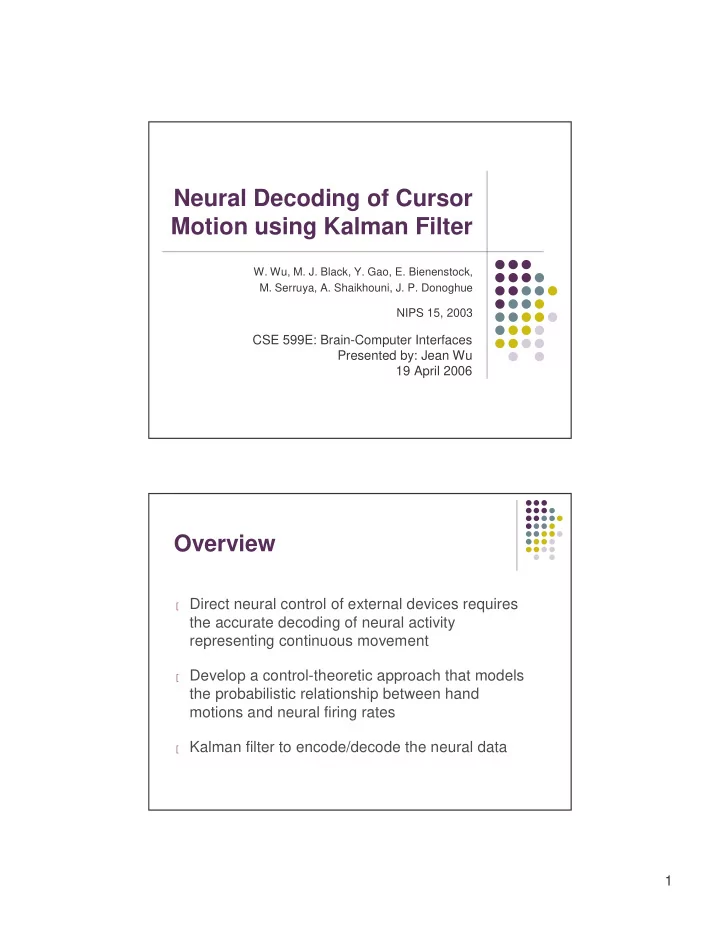

Neural Decoding of Cursor Motion using Kalman Filter W. Wu, M. J. Black, Y. Gao, E. Bienenstock, M. Serruya, A. Shaikhouni, J. P. Donoghue NIPS 15, 2003 CSE 599E: Brain-Computer Interfaces Presented by: Jean Wu 19 April 2006 Overview [ Direct neural control of external devices requires the accurate decoding of neural activity representing continuous movement [ Develop a control-theoretic approach that models the probabilistic relationship between hand motions and neural firing rates [ Kalman filter to encode/decode the neural data 1
Overview Using a mathematical decoding method to produce an estimate of the system “state” from a sequence of “observations” “State” – hand movement (position, velocity, and acceleration) “Observation” – measurement of the neural firing rates Overview Decoding method should: Have good probabilistic foundation Model noise in the data explicitly Indicate uncertainty in state estimations Make minimal assumptions about the data 2
Overview Decoding method should: Require minimal ‘training’ data On-line estimation with short delay (< 200 ms ) Provide insight into the neural coding of movement � � � � Kalman Filtering Method Experimental Setup l A 100-microelectrode array implanted in the arm area of primary motor cortex of a monkey Fig: http://donoghue.neuro.brown.edu/pubs/capri%20IEEE%20review.pdf 3
Experimental Setup l The monkey views a computer screen while gripping a two-link manipulandum that controls 2D motion of a cursor on the screen l Task: move the manipulandum on a 30x30 cm 2 tablet (20x20 cm 2 working space) to hit the randomly placed targets Experiment Setup l Record the trajectory of the hand and neural activity of 42 cells simultaneously l Firing rate 70 ms l Assume the observation (firing rate) is a linear function of the state + Gaussian noise* 4
Fixed Linear Filter Compute hand position as a linear combination of neural firing rates over some fixed time period Fixed Linear Filter x k : x -position at time t k = k � t ( � t = 70ms), k = 1, …, M and M is the number of time steps in a trial a : constant offset v r − : firing rate of neuron v at time t k-j k j : filter coefficients (learn from training data using least-square) 5
Kalman Filter (Encoding) Generative model of neural firing H = a matrix that linearly relates hand state to neural firing Assume the noise in observations is zero mean and normally distributed ! Current state linearly causes the observed firing rate Kalman Filter (Encoding) Generative model of neural firing A = coefficient matrix ! the state at time k +1 is linearly related to the state at time k 6
Kalman Filter (Decoding) Discrete time update equation: 6 Prediction of the a priori state estimate 6 obtain the estimate at time t k from time t k-1 then compute its error covariance matrix P k- Kalman Filter (Decoding) Measurement update equation: B Update the estimate with new measurement data to produce a posteriori state estimate B P k = state error covariance after taking into account the neural data B K k = Kalman gain matrix 7
Experiment Reconstructing 2D Hand Motion Training Decoding Results ’ ~3.5min of training data (same as linear filtering method) ’ Results use ~1min test data ’ Optimal Lag ~140 ms (two time steps) 8
Results Reconstruction Results Results Reconstructed Trajectories Red: true target trajectory Blue: reconstruction using Kalman filter 9
Comparison with linear filtering Linear filter: D not benefit from use of time-lagged data D not explicitly reconstruct velocity or acceleration C Kalman filter gives higher correlation coefficient and lower mean-squared error � more accurate reconstruction Reconstruction of Position using Kalman Filter Red: true target trajectory Blue: reconstruction using Kalman filter 10
Reconstruction of Position using Linear Filter Red: true target trajectory Blue: reconstruction using linear filter Conclusions The Kalman filter model can be easily learned using a few min of training data and provides real-time estimates of hand position every 70 ms given the firing rates of 42 cells in primary motor cortex 11
Conclusions The estimated trajectories are more accurate than the fixed linear filtering results The Kalman filter provides a rigorous probabilistic approach with well understood theory. 12
Recommend
More recommend